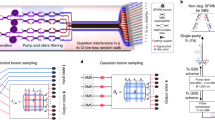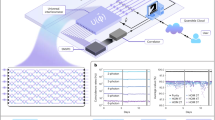Abstract
Growing interest in quantum computing for practical applications has led to a surge in the availability of programmable machines for executing quantum algorithms1,2. Present-day photonic quantum computers3,4,5,6,7 have been limited either to non-deterministic operation, low photon numbers and rates, or fixed random gate sequences. Here we introduce a full-stack hardware−software system for executing many-photon quantum circuit operations using integrated nanophotonics: a programmable chip, operating at room temperature and interfaced with a fully automated control system. The system enables remote users to execute quantum algorithms that require up to eight modes of strongly squeezed vacuum initialized as two-mode squeezed states in single temporal modes, a fully general and programmable four-mode interferometer, and photon number-resolving readout on all outputs. Detection of multi-photon events with photon numbers and rates exceeding any previous programmable quantum optical demonstration is made possible by strong squeezing and high sampling rates. We verify the non-classicality of the device output, and use the platform to carry out proof-of-principle demonstrations of three quantum algorithms: Gaussian boson sampling, molecular vibronic spectra and graph similarity8. These demonstrations validate the platform as a launchpad for scaling photonic technologies for quantum information processing.
This is a preview of subscription content, access via your institution
Access options
Access Nature and 54 other Nature Portfolio journals
Get Nature+, our best-value online-access subscription
$29.99 / 30 days
cancel any time
Subscribe to this journal
Receive 51 print issues and online access
$199.00 per year
only $3.90 per issue
Buy this article
- Purchase on Springer Link
- Instant access to full article PDF
Prices may be subject to local taxes which are calculated during checkout






Similar content being viewed by others
Data availability
All data underlying the findings of this work are available upon request from the authors.
Code availability
Codes used for data analysis in this work are available upon request from the authors. The Supplementary Information contains example Strawberry Fields code, parameters of the theoretical model, and interferometer unitaries used in the demonstrations.
References
Wright, K. et al. Benchmarking an 11-qubit quantum computer. Nat. Commun. 10, 5464 (2019).
Arute, F. et al. Quantum supremacy using a programmable superconducting processor. Nature 574, 505–510 (2019).
Larsen, M. V., Guo, X., Breum, C. R., Neergaard-Nielsen, J. S. & Andersen, U. L. Deterministic generation of a two-dimensional cluster state. Science 366, 369–372 (2019).
Asavanant, W. et al. Generation of time-domain-multiplexed two-dimensional cluster state. Science 366, 373–376 (2019).
Qiang, X. et al. Large-scale silicon quantum photonics implementing arbitrary two-qubit processing. Nat. Photon. 12, 534–539 (2018).
Paesani, S. et al. Generation and sampling of quantum states of light in a silicon chip. Nat. Phys. 15, 925–929 (2019).
Zhong, H.-S. et al. Experimental Gaussian boson sampling. Sci. Bull. 64, 511–515 (2019).
Bromley, T. R. et al. Applications of near-term photonic quantum computers: Software and algorithms. Quant. Sci. Technol. 5, 034010 (2020).
Kielpinski, D., Monroe, C. & Wineland, D. J. Architecture for a large-scale ion-trap quantum computer. Nature 417, 709–711 (2002).
Clarke, J. & Wilhelm, F. K. Superconducting quantum bits. Nature 453, 1031–1042 (2008).
Wootton, J. R. & Loss, D. Repetition code of 15 qubits. Phys. Rev. A 97, 052313 (2018).
Dumitrescu, E. F. et al. Cloud quantum computing of an atomic nucleus. Phys. Rev. Lett. 120, 210501 (2018).
Anschuetz, E., Olson, J., Aspuru-Guzik, A. & Cao, Y. Variational quantum factoring. In Int. Worksh. on Quantum Technology and Optimization Problems 74–85 (Springer, 2019).
Nielsen, M. A. & Chuang, I. Quantum Computation And Quantum Information (Cambridge Univ. Press, 2010).
Preskill, J. Quantum computing in the NISQ era and beyond. Quantum 2, 79 (2018).
Gottesman, D., Kitaev, A. & Preskill, J. Encoding a qubit in an oscillator. Phys. Rev. A 64, 012310 (2001).
Flühmann, C. et al. Encoding a qubit in a trapped-ion mechanical oscillator. Nature 566, 513–517 (2019).
Huh, J., Guerreschi, G. G., Peropadre, B., McClean, J. R. & Aspuru-Guzik, A. Boson sampling for molecular vibronic spectra. Nat. Photon. 9, 615 (2015).
Arrazola, J. M. & Bromley, T. R. Using Gaussian boson sampling to find dense subgraphs. Phys. Rev. Lett. 121, 030503 (2018).
Brádler, K., Friedland, S., Izaac, J., Killoran, N. & Su, D. Graph isomorphism and gaussian boson sampling. Preprint at https://arxiv.org/abs/1810.10644 (2018).
Brádler, K., Dallaire-Demers, P.-L., Rebentrost, P., Su, D. & Weedbrook, C. Gaussian boson sampling for perfect matchings of arbitrary graphs. Phys. Rev. A 98, 032310 (2018).
Schuld, M., Brádler, K., Israel, R., Su, D. & Gupt, B. Measuring the similarity of graphs with a Gaussian boson sampler. Phys. Rev. A 101, 032314 (2020).
Banchi, L., Fingerhuth, M., Babej, T., Ing, C. & Arrazola, J. M. Molecular docking with Gaussian boson sampling. Sci. Adv. 6, eaax1950 (2020).
Killoran, N. et al. Continuous-variable quantum neural networks. Phys. Rev. Res. 1, 033063 (2019).
Arrazola, J. M., Kalajdzievski, T., Weedbrook, C. & Lloyd, S. Quantum algorithm for nonhomogeneous linear partial differential equations. Phys. Rev. A 100, 032306 (2019).
Wang, J., Sciarrino, F., Laing, A. & Thompson, M. G. Integrated photonic quantum technologies. Nat. Photon. 14, 273–284 (2019).
Rudolph, T. Why I am optimistic about the silicon-photonic route to quantum computing. APL Photon. 2, 030901 (2017).
Hamilton, C. S. et al. Gaussian boson sampling. Phys. Rev. Lett. 119, 170501 (2017).
Lvovsky, A. Squeezed light. In Photonics Vol. 1 Fundamentals of Photonics and Physics 121–164 (Wiley, 2015)
Vaidya, V. D. et al. Broadband quadrature-squeezed vacuum and nonclassical photon number correlations from a nanophotonic device. Sci. Adv. 6, eaba9186 (2020).
Killoran, N. et al. Strawberry Fields: a software platform for photonic quantum computing. Quantum 3, 129 (2019).
Rosenberg, D., Lita, A. E., Miller, A. J. & Nam, S. W. Noise-free high-efficiency photon-number-resolving detectors. Phys. Rev. A 71, 061803 (2005).
Qi, H., Brod, D. J., Quesada, N. & García-Patrón, R. Regimes of classical simulability for noisy Gaussian boson sampling. Phys. Rev. Lett. 124, 100502 (2020).
Aytür, O. & Kumar, P. Pulsed twin beams of light. Phys. Rev. Lett. 65, 1551 (1990).
Christ, A., Laiho, K., Eckstein, A., Cassemiro, K. N. & Silberhorn, C. Probing multimode squeezing with correlation functions. New J. Phys. 13, 033027 (2011).
Glauber, R. J. Coherent and incoherent states of the radiation field. Phys. Rev. 131, 2766 (1963).
Sudarshan, E. Equivalence of semiclassical and quantum mechanical descriptions of statistical light beams. Phys. Rev. Lett. 10, 277 (1963).
Burenkov, I. A. et al. Full statistical mode reconstruction of a light field via a photon-number-resolved measurement. Phys. Rev. A 95, 053806 (2017).
Aaronson, S. & Arkhipov, A. The computational complexity of linear optics. Theor. Comput. 9, 143–252 (2013).
Quesada, N. Franck-Condon factors by counting perfect matchings of graphs with loops. J. Chem. Phys. 150, 164113 (2019).
Brádler, K., Israel, R., Schuld, M. & Su, D. A duality at the heart of gaussian boson sampling. Preprint at https://arxiv.org/abs/1910.04022 (2019).
Vernon, Z. et al. Scalable squeezed-light source for continuous-variable quantum sampling. Phys. Rev. Appl. 12, 064024 (2019).
Clements, W. R., Humphreys, P. C., Metcalf, B. J., Kolthammer, W. S. & Walmsley, I. A. Optimal design for universal multiport interferometers. Optica 3, 1460–1465 (2016).
Levine, Z. H. et al. Algorithm for finding clusters with a known distribution and its application to photon-number resolution using a superconducting transition-edge sensor. J. Opt. Soc. Am. B 29, 2066–2073 (2012).
Humphreys, P. C. et al. Tomography of photon-number resolving continuous-output detectors. New J. Phys. 17, 103044 (2015).
Vignat, C. A generalized Isserlis theorem for location mixtures of Gaussian random vectors. Stat. Probab. Lett. 82, 67–71 (2012).
Pfeiffer, M. H. P. et al. Photonic damascene process for low-loss, high-confinement silicon nitride waveguides. IEEE J. Sel. Top. Quant. Electron. 24, 1–11 (2018).
Rahimi-Keshari, S., Ralph, T. C. & Caves, C. M. Sufficient conditions for efficient classical simulation of quantum optics. Phys. Rev. X 6, 021039 (2016).
Gupt, B., Izaac, J. & Quesada, N. The Walrus: a library for the calculation of hafnians, Hermite polynomials and Gaussian boson sampling. J. Open Source Softw. 4, 1705 (2019).
Caianiello, E. R. On quantum field theory–I: explicit solution of Dyson’s equation in electrodynamics without use of Feynman graphs. Il Nuovo Cimento 10, 1634–1652, (1953).
Lund, A. P. et al. Boson sampling from a gaussian state. Phys. Rev. Lett. 113, 100502 (2014).
Brod, D. J. & Oszmaniec, M. Classical simulation of linear optics subject to nonuniform losses. Quantum 4, 267 (2020).
Sharp, T. & Rosenstock, H. Franck–Condon factors for polyatomic molecules. J. Chem. Phys. 41, 3453–3463 (1964).
Sawaya, N. P., Paesani, F. & Tabor, D. P. Near-and long-term quantum algorithmic approaches for vibrational spectroscopy. Preprint at https://arxiv.org/abs/2009.05066 (2020).
Mebel, A., Hayashi, M., Liang, K. & Lin, S. Ab initio calculations of vibronic spectra and dynamics for small polyatomic molecules: Role of duschinsky effect. J. Phys. Chem. A 103, 10674–10690 (1999).
Müller, C. W., Newby, J. J., Liu, C.-P., Rodrigo, C. P. & Zwier, T. S. Duschinsky mixing between four non-totally symmetric normal coordinates in the s 1–s 0 vibronic structure of (E)-phenylvinylacetylene: a quantitative analysis. Phys. Chem. Chem. Phys. 12, 2331–2343 (2010).
Acknowledgements
Certain commercial equipment, instruments, or materials are identified in this paper to foster understanding. Such identification does not imply recommendation or endorsement by the National Institute of Standards and Technology, nor does it imply that the materials or equipment identified are necessarily the best available for the purpose.
Author information
Authors and Affiliations
Contributions
B.M., D.H.M., A.G., J.L., M.M., K.T., Z.V. and Y.Z. designed and tested the chip, and developed its components. D.H.M. also led the development of the control hardware system, designing and building the machine alongside A.R. and V.D.V. M.J.C., T.G., A.E.L. and S.W.N. developed the photon detection system. L.N., L.G.H. and J.H. developed the control and data acquisition software. V.B., A.F., T.I., J.I., R.J., N.K., N.Q., J.S., A.S., P.T. and Z.Z. designed and deployed the platform for remote programming of the device. J.M.A., K.B., T.B., R.I., S.J., K.K.S., M.S. and D.S. designed, and implemented the demonstrations. I.D., S.P.K., H.Y.Q. and N.Q. designed and implemented the non-classicality test. Z.V. and J.M.A. led the project and wrote the manuscript with input from all authors.
Corresponding authors
Ethics declarations
Competing interests
The authors declare no competing interests.
Additional information
Peer review information Nature thanks the anonymous reviewer(s) for their contribution to the peer review of this work.
Publisher’s note Springer Nature remains neutral with regard to jurisdictional claims in published maps and institutional affiliations.
Supplementary information
Supplementary Information
This file contains Strawberry Fields coding, Supplementary Tables and Graphs.
Rights and permissions
About this article
Cite this article
Arrazola, J.M., Bergholm, V., Brádler, K. et al. Quantum circuits with many photons on a programmable nanophotonic chip. Nature 591, 54–60 (2021). https://doi.org/10.1038/s41586-021-03202-1
Received:
Accepted:
Published:
Issue Date:
DOI: https://doi.org/10.1038/s41586-021-03202-1
This article is cited by
-
Light squeezing enhancement by coupling nonlinear optical cavities
Scientific Reports (2024)
-
Speeding up the classical simulation of Gaussian boson sampling with limited connectivity
Scientific Reports (2024)
-
Quantum-inspired classical algorithms for molecular vibronic spectra
Nature Physics (2024)
-
Scalable and efficient grating couplers on low-index photonic platforms enabled by cryogenic deep silicon etching
Scientific Reports (2024)
-
Finite barrier bound state
Light: Science & Applications (2024)
Comments
By submitting a comment you agree to abide by our Terms and Community Guidelines. If you find something abusive or that does not comply with our terms or guidelines please flag it as inappropriate.



